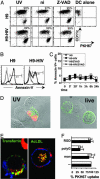Dendritic cells cross-present HIV antigens from live as well as apoptotic infected CD4+ T lymphocytes
- PMID: 15079077
- PMCID: PMC395928
- DOI: 10.1073/pnas.0304860101
Dendritic cells cross-present HIV antigens from live as well as apoptotic infected CD4+ T lymphocytes
Abstract
A better understanding of the antigen presentation pathways that lead to CD8(+) T cell recognition of HIV epitopes in vivo is needed to achieve better immune control of HIV replication. Here, we show that cross-presentation of very small amounts of HIV proteins from apoptotic infected CD4(+) T lymphocytes by dendritic cells to CD8(+) T cells is much more efficient than other known HIV presentation pathways, i.e., direct presentation of infectious virus or cross-presentation of defective virus. Unexpectedly, dendritic cells also take up actively antigens into endosomes from live infected CD4(+) T lymphocytes and cross-present them as efficiently as antigens derived from apoptotic infected cells. Moreover, live infected CD4(+) T cells costimulate cross-presenting dendritic cells in the process. Therefore, dendritic cells can present very small amounts of viral proteins from infected T cells either after apoptosis, which is frequent during HIV infection, or not. Thus, if HIV expression is transiently induced while costimulation is enhanced (for instance after IL-2 and IFNalpha immune therapy), this HIV antigen presentation pathway could be exploited to eradicate latently infected reservoirs, which are poorly recognized by patients' immune systems.
Figures





Similar articles
-
Apoptotic killing of CD4+ T lymphocytes in HIV-1-infected PHA-stimulated PBL cultures is mediated by CD8+ LAK cells.Virology. 1998 Feb 15;241(2):169-80. doi: 10.1006/viro.1997.8979. Virology. 1998. PMID: 9499792
-
Efficient virus transmission from dendritic cells to CD4+ T cells in response to antigen depends on close contact through adhesion molecules.Virology. 1997 Dec 22;239(2):259-68. doi: 10.1006/viro.1997.8895. Virology. 1997. PMID: 9434717
-
CD4+ T cell-mediated presentation of non-infectious HIV-1 virion antigens to HIV-specific CD8+ T cells.Chin Med J (Engl). 2006 Oct 5;119(19):1629-38. Chin Med J (Engl). 2006. PMID: 17042976
-
Are blockers of gp120/CD4 interaction effective inhibitors of HIV-1 immunopathogenesis?AIDS Rev. 2006 Jan-Mar;8(1):3-8. AIDS Rev. 2006. PMID: 16736946 Review.
-
[Dendritic cells of spleen and blood and HIV-1 infection].Pathol Biol (Paris). 1995 Dec;43(10):889-96. Pathol Biol (Paris). 1995. PMID: 8786895 Review. French.
Cited by
-
Dendritic cell-based human immunodeficiency virus vaccine.J Intern Med. 2009 Jan;265(1):138-58. doi: 10.1111/j.1365-2796.2008.02047.x. J Intern Med. 2009. PMID: 19093966 Free PMC article. Review.
-
Antigen cross-presentation by dendritic cell subsets: one general or all sergeants?Trends Immunol. 2013 Aug;34(8):361-70. doi: 10.1016/j.it.2013.02.007. Epub 2013 Mar 27. Trends Immunol. 2013. PMID: 23540650 Free PMC article.
-
Vaccine adjuvants to engage the cross-presentation pathway.Front Immunol. 2022 Aug 1;13:940047. doi: 10.3389/fimmu.2022.940047. eCollection 2022. Front Immunol. 2022. PMID: 35979365 Free PMC article. Review.
-
Dendritic cells crosspresent antigens from live B16 cells more efficiently than from apoptotic cells and protect from melanoma in a therapeutic model.PLoS One. 2011 Apr 28;6(4):e19104. doi: 10.1371/journal.pone.0019104. PLoS One. 2011. PMID: 21552572 Free PMC article.
-
Immunomodulatory Effects of Non-Thermal Plasma in a Model for Latent HIV-1 Infection: Implications for an HIV-1-Specific Immunotherapy.Biomedicines. 2023 Jan 3;11(1):122. doi: 10.3390/biomedicines11010122. Biomedicines. 2023. PMID: 36672628 Free PMC article.
References
-
- Letvin, N. L. & Walker, B. D. (2003) Nat. Med. 9, 861-866. - PubMed
-
- Wilson, J. D., Ogg, G. S., Allen, R. L., Davis, C., Shaunak, S., Downie, J., Dyer, W., Workman, C., Sullivan, S., McMichael, A. J. & Rowland-Jones, S. L. (2000) AIDS 14, 225-233. - PubMed
-
- Blankson, J. N., Persaud, D. & Siliciano, R. F. (2002) Annu. Rev. Med. 53, 557-593. - PubMed
Publication types
MeSH terms
Substances
LinkOut - more resources
Full Text Sources
Other Literature Sources
Research Materials

